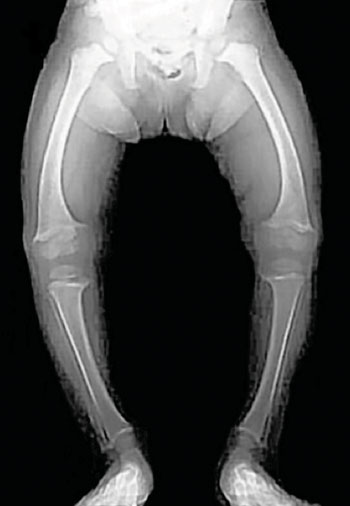Low Vitamin D Levels May Harm Heart Health
By LabMedica International staff writers
Posted on 23 Nov 2015
Vitamin D is important for bone health, promoting calcium absorption, but studies have increasingly suggested the vitamin may also play an important role in heart health, linking vitamin D deficiency to increased risk for high blood pressure, heart attack and heart disease.Posted on 23 Nov 2015
Individuals who do not get enough vitamin D through dietary sources including oily fish, eggs, and supplements or sun exposure often have vitamin D deficiency as when the levels of the vitamin in the body are too low, which is determined by measuring levels of 25-hydroxyvitamin D (25-OHD) in the blood.

Image: Radiograph of a child suffering a deficiency of vitamin D and has manifested symptoms of the disease Nutritional Rickets (Photo courtesy of Dr. Michael L. Richardson, MD).
Scientists at the Intermountain Medical Center Heart Institute (Salt Lake City, UT, USA) assessed how vitamin D levels affected the health of more than 230,000 patients who were on their database. The team allocated each patient into one of four groups dependent on their 25-OHD levels: less than 15 ng/mL, 15–29 ng/mL, 30–44 ng/mL, and more than 45 ng/mL. Over the next three years, they monitored the patients for any incidence of major cardiac events, including coronary heart disease, heart attack, stroke and heart failure, as well as incidence of kidney failure and death.
The investigators found that patients whose 25-OHD levels were less than 15 ng/mL were 35% more likely to experience a cardiovascular event in the subsequent three years than participants in the other three groups. The risk for cardiovascular events was the same for participants whose 25-OHD levels were 15–29 ng/mL, 30–44 ng/mL, or more than 45 ng/mL, according to the results. Accordingly, these findings indicate that if a person's 25-OHD levels are 15–29 ng/mL or above, they should not be concerned about the effect their vitamin D levels may have on their heart, and vitamin D supplementation is unlikely to improve heart health any further.
J. Brent Muhlestein, MD, the lead author of the study, said, “Although vitamin D levels above 30 were traditionally considered to be normal, more recently, some studies have proposed that anything above 15 was a safe level. But the numbers had not been backed up with any studies until now. Even if any level above 15 is safe, one out of 10 people still have vitamin D levels lower than that. This equates to a very large percentage of our population. The best way to determine one’s vitamin D level is by getting a blood test.” The study was presented on November 9, 2015, at the American Heart Association's Scientific Sessions held Orlando, FL, USA).
Related Links:
Intermountain Medical Center Heart Institute














